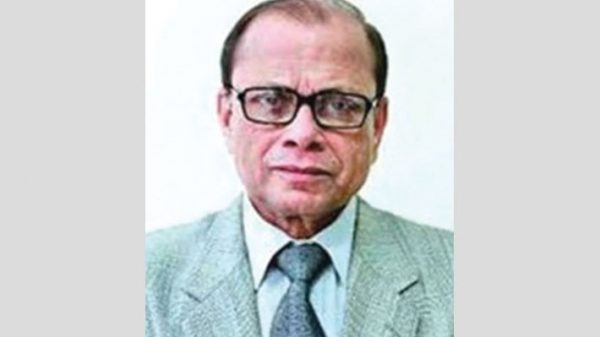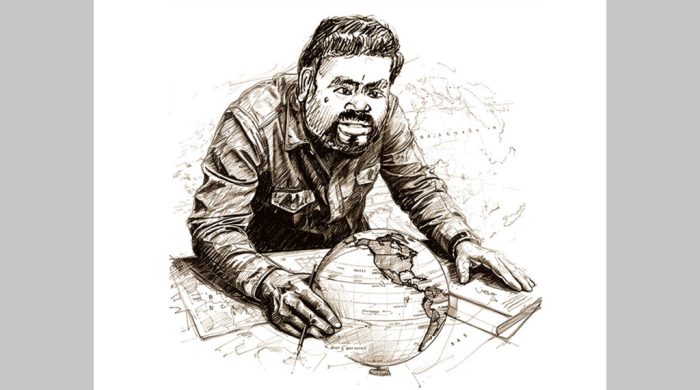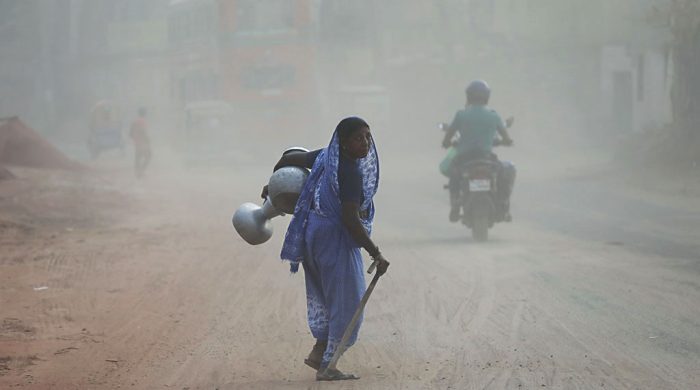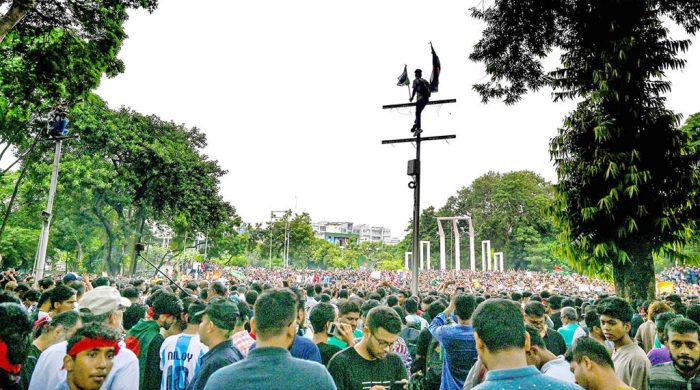Bangabandhu, Bangladesh and Bangali Emancipation

- Update Time : Monday, September 6, 2021
- 149 Time View

The genesis of Bangladesh as an independent entity stretches back to at least 6th century, when Sasanka had established the independent kingdom of Gaur in 594 A.D. , by repudiating the foreign Gupta rule over Bengal. Sasanka was a Bangali, and his kingdom was the first independent Bangali entity in recorded history. The next episode of Bengal’s independence was provided by the Pala rule (700-1161). The Palas were sons of the soil; and their empire had a niche in the subcontinental history as being the most revered and even feared. The Muslim rule of the independent sultans (1336-1576) was the next phase of Bengal’s independence. The Muslim rulers were, however, outsiders, who had their own compulsions to keep their realm administratively and economically independent of Delhi Sultanate’s control. But Bangali people were not independent; nevertheless, they did have their status as being the denizens of an independent kingdom. Thus from the ancient through the medieval times, Bengal had spells of independence many a time, administrative and otherwise. Monarchy, being the prevailing mode of administration, people had little or nothing to do with this sort of administration. The first ever political entity with people’s voice and participation in it, was Bangladesh (1971), and the architect of which was Bangabandhu Sheikh Mujibur Rahman. The state of Pakistan, to which Eastern Bengal was tugged as East Pakistan for 24 years 4 months and 3 days (1947-1971), was a period of domination and discrimination. This was, however, a period of gestation of Bangali urge for self-assertion, and during which, Bangabandhu was the prime leader of people calling the shots. The leader – people nexus was such that people bestowed upon him the epithets of Bangabandhu and the Father of Nation. During the 1,314 days he was at the helm of affairs following independence and upto assassination, Bangabandhu, despite circumstantial odds, did try his utmost to repay people’s debt by delivering the expected goods of independence. A peoplecentric leader as he was, Bangabandhu’s deeds for Bangladesh divide into two phases: pre and post-BKSAL. The former phase, although not without evidential slips, did witness successes enough to put a totally devastated country on the sure road of recoveryand progress. The latter phase was an unfinished one as Bangabandhu’s life-span was rendered unfinished (55 years 4 months and 3 days) by the self-confessed killers.
Bangabandhu and the Making of Bangladesh
Bangabandhu and Bangladesh are historically and epistemologically synonymous. Bangabandhu was personally the seer, but also the creator, of course, with people’s input, of the Bangladesh project. The independence of Bangladesh, in its origin and evolution, was egged on by his personal political philosophical cogitation. In 1974, he was reported to have confided in the eminent litterateur Anyadashankar Roy that he had conceived the idea of an independent Bangladesh state as far back as 1947; and there are ample historical evidences to substantiate such a claim.
In 1960, he joined hands with some progressive youths to float the Swadhin Bangla Biplabi Parishad (Independent Bengal Revolutionary Council). A secret and apparently socio-cultural body, its very name suggested a political agenda. Spread throughout the province, some carefully selected youths were imbued with the idea of independence. A note is to be added here that, while engaging himself in such furtive adventurous deeds, Bangabandhu had been serving as the Awami League General Secretary (1953-1966). It is understandable that, the Awami League, although a Bangali-oriented party, Bangabandhu appeared to have a deficit in his satisfaction of the party agenda insofar as Bangali emancipation was concerned; and, hence is explained his personal adventurous bids. He would continue in this line of action until independence was achieved.
In 1961, Bangabandhu was a catalyzer for two such secret bids. To craft a consensus vis-a-vis the question of independence, he sought to reach across to the left political parties. Facilitated by Manik Mia, there was a secret meeting with comrades KhokaRoy and Moni Singh, wherein Bangabandhu sought their assistance in the bid for independence. While seeing eye to eye with the proposition, both the comrades advised caution for being secretive, as any public disclosure would bring in anti-Bangali dictator Ayub’s wrath. Both sides, however, agreed to concert their movements to reach theultimate goal of independence.
The second bid was to launch his entirely personal Purbavanga Mukti Front (East Bengal Liberation Front). A leaflet drafted in English by himself, was printed at his own cast. The leaflet was delivered mostly by himself to foreign missions located in Dhaka riding his own bicycle. The object was to sensitize the foreign missions about grievances and goal of Bangali people.
As there is contradictory evidence about the year of the secret trip to Agartala, we prefer to be noncontroversial by citing the years 1962-63. Bangabandhu’s Agartala mission had the aim of going to London with Indian help for starting his movement in exile from there. It is understandable that for such a political strategy Bangabandhu had taken his cue from that of Subhas Chandra Bose’s, who had enlisted support and assistance of Germany and Japan to end British rule in India. But in the wake of the humiliating Sino-Indian War, Prime Minister Nehru shruggad off any such secret move to help Bangabandhu’s genuine but ambitious plan; and, Bangabandhu returned home empty handed. Apparently a failure, this mission was, however, indicative of Bangabandhu’s intensity of purpose, and for the achievement of which he even hazarded his personal safety.
The next way station towards independence was the Six Point programme and the rousing movement issuing therefrom. Dubbed the charter of emancipation, the programme initially sketched out a plan for political emancipation; and, socio-economic emancipation would wait until independence was achieved. Inhering in the programme was political, economic and military autonomy of the then East Pakistan as had been adumbrated in the Lahore Resolution (23 March 1940). As to the ultimate goal of the programme, Bangabandhu bared his mind to the NAP (pro-Moscow) supremo Professor Muzaffar Ahmed that his was only one point of independence put across equivocally (as reported to this writer by Prof. Ahmed).
The Ayub regime retorted to the Six Point demand by foisting upon Bangabandhu and 34 other pro-Bangali civil and military persons the Agartala Conspiracy Case (Bangabandhu called Islamabad Conspiracy Case). The youth movement, called the 1969 Mass Uprising, was mounted to confront the trial of Bangabandhu and others under this case. The slogans raised by the youth as the uprising gathered stridency showed the extent and depth of public support for the demand of independence. Under the sheer weight of popular movement, the Ayub regime retracted; the case was withdrawn on 22 February, Bangabandhu along with other accuseds were released. This episode demonstrated the strength of people power against even a military dictatorial regime. This was also a portent of the things to come vis-a-vis the run-off towards independence. Moreover, this was a litmus test of leadership for Bangabandhu, which he got through successfully, as on the following day after his release, a public reception at the then Race Course bestowed upon him the epithet of Bangabandhu. Indeed, the Six Point movement and the conspiracy case sky-rocketed Bangabandhu’s popularity, and catapulted him to the position of the sole Bangali spokesman.
On 5 December 1969, at the memorial meeting on the sixth death anniversary of Suhrawardy, Bangabandhu named East Pakistan Bangladesh. This declaration was certainly inches forward to the cause of independent Bangladesh.
The 1970 general elections were about to be boycotted as many senior Awami League leaders were averse to participating in meaningless elections, because of the restrictions that had been imposed by Yahya Khan’s (the general who had replaced Ayub Khan on 25 March 1969) Legal Framework Order (LFO). This document sought to tie the hands of Bangabandhu in way that he would not be able to recast the constitution as per the Six Points. But Bangabandhu let it be known that his party would surely take part in the elections and fumed, “My goal is the independence of Bangladesh. Once the elections are over I shall tear the LFO into shreds. Who can then challenge me.” This statement originated out of his immense self-confidence that he and his party would win the elections. History thereafter substantiated this self-confidence and rare farsightedness of Bangabandhu.
In the National Assembly, the Awami League bagged 167 out of allotted 169 seats; in the provincial assembly 288 out of 300 seats. Thus the party garnered a landslide victory, and the architect of which was charismatic Bangabandhu himself. But the winning party was denied the expected political space through the machinations of the triumvirate comprising Yahya, the military and over-ambitious Bhutto. Even the National Assembly, scheduled to begin its session in Dhaka on 3 March, was postponed without giving a new date. The Bangali people, led by Bangabandhu, reacted by mounting the unprecedented non-cooperation movement thus creating the tumultuous March days (1-25 March), which, in fact, were the distant thunder for the Pakistan military junta.
The tumultuous March days were marked by number of milestone-like events as Bangladesh neared independence. First, on 2 March, the Swadhin Bangla Chhatra Sangram Parishad hoisted the green-red-golden flag of the would-be independent country atop the Arts Building of the University of Dhaka. Second, on 3 March, the same group of youths, at their Paltan rally, proclaimed the manifesto of independence, wherein Bangabandhu was declared to be the supreme leader of the Bangladesh movement. In other words, he was accorded the position of the Father of the Nation. Third, Bangabandhu’s decisive speech of 7 March gave an equivocal call for independence to be achieved through a people’s war fought with guerilla tactics. Fourth, there were Mujib-Yahya parleys, joined later by Bhutto, between 16 and 24 March. Bangabandhu’s intent on joining the parlays was to get across the message that he had hoped for a political solution to the political impasse. Yahya plus Bhutto had a different bent of mind; they were dilly-dallying to buy time to complete military preparations for the eventual military assault on the people. The philosophical basis for a military solution to political crisis had been decided as far back as February 1971, when Yahya, in a meeting of generals, was reported to have roared, “kill three million of them [Bangalis], the rest will eat out of our hands.” It appears that by 25 March, military preparations had been complete for launching the Operation Searchlight; thus having given green signal for the operation, Yahya eased himself out of Dhaka in the evening of 25 March. Bhutto did the same thing in the following morning with the self-congratulatory words, “Thank God, Pakistan has been saved.” He would soon realize that, in fact, this was beginning of death-throes of Pakistan.
In his interview with David Frost (18 January 1972), Bangabandhu divulged that he would have liked the Pakistan side to attack first and then the people would be in war in self-defense. This was exactly how things happened following the launching of the Operation Searchlight by about 11.p.m. . Moreover, he had now ample reasons for making a formal declaration of independence. As it was, by 12:20 am, Bangabandhu recorded his declaration, which began with the words, “This may be my last message. From today Bangladesh is independent.” By 1:30 a.m., he was arrested, and later transported to Pakistan, where he had to pass 290 days of solitary imprisonment. Death was staring at him.
As Bangabandhu was in incarceration, Bangladesh confronted the Pakistan occupation forces. As per the directives contained in the 7 March speech, the people, especially the freedom fighters, waged a people’s guerilla war. The resultant Liberation War of 8 months and 21 days (not 9 months) was the shortest of such wars in history. Although physically away in Pakistani captivity, Bangabandhu remained the guiding sprit and beacon light as his people trudged along the uphill path of war. This kind of non-physical and entirely spiritual leadership is perhaps a rarity in the annals of leadership. The war was fought to success. In this asymmetric war, Bangladesh was the weaker side; but despite that, the occupation forces capitulated and surrendered humiliatingly on 16 December 1971. Once again, the enormous might of people power prevailed over the marauding military juggernaut. Indeed, Bangladesh is the gift of a nexus between the leadership and people power.
Bangabandhu and People’s Emancipation in Bangladesh
It was sheer providence plus international pressure to save his life, in the lead of which was the Indian Premier Indira Gandhi, that Bangabandhu could come back alive (if not fully well) to Bangladesh in the afternoon of 10 January 1972. On the homecoming of Bangabandhu, The Guardian made the most pertinent comment: “As soon as Sheikh Mujib walks out of the Dhaka airport, the Republic of Bangladesh becomes a reality.” Indeed, without Bangabandhu the existence of Bangladesh would have been at stake; that was how we thought as well as the international media. Equally salient was the cover-page comment of the weekly Time; “Bangladesh from Jail to Power;” and there was a full-page bust-size picture of Bangabandhu on the cover-page. It is worth noting that Bangabandhu was equated with Bangladesh; and rightly so.
Once in Bangladesh, Bangabandhu had to start almost from zero to build a Bangladesh, a country which had emerged with Dr. Henry Kissingar’s prognostication that the same would be a bottomless basket. In a 1976 publication, Just Faaland and J.R. Parkinson (Bangladesh: The Test Case for Development) also forecast a bleak future of Bangladesh. But to the surprise of international development pundits, Bangladesh economy during the life-time of Bangabandhu grew at the average rate of 7 percent.
In his homecoming address, Bangabandhu gave out ample indications as to how he would go about the arduos task of rebuilding the country. One such major indication was that, “Bangladesh will be an ideal state; and the basis of which will not be any religion. The basis of the state will be democracy, socialism and secularism (nationalism was added at the time of writing the constitution). The people were exhorted to wage “a struggle for emancipation.” On 14 March 1972, in a speech Bangabandhu raised the slogan: “This time the struggle is for building the country.”
Bangabandhu’s vision for an exploitation-free Sonar Bangla (golden Bengal) was succinctly put forward in his Rajshahi address of 9 May 1972. He said, “what do I want? I want the people of Bangla to get two square meals a day. What do I want? I want the jobless to get job. What do I want? I want the people of my Bengal become happy. What do I want? I want that my people move about in a jolly mood. What do I want? I want the people of Bangla smile again to their heart’s content.”
Bangabandhu had, in total 1,314 days, to serve the country, which were divided into two phases: pre-BKSAL (10 January 1972 – 24 January 1975), and post-BKSAL 233 days. During the first phase, the trend was to reconstruct Bangladesh with whatever was available, administrative and otherwise. There was, in fact, no time to improvise everything new; the imperative was first to bring back the totally devastated country to at least a running position. Consequently, mostly the Pakistani personnel and machine hurtled along in the new Bangladesh. The experience which Bangabandhu gathered during this phase had been a mixed one. Indeed, the turn-around by the BKSAL was an inevitable consequence of what had happened during the first phase. Bangabandhu himself characterized the new system as the democracy of the oppressed in a socialist matrix. The BKSAL had all the potentialities to effect a revolutionary turn-around for Bangladesh. Bangabandhu himself dubbed the BKSAL the ‘Second Revolution’; meaning 1971 to be the first. But it is humbly suggested that as per definition and implied meaning of the construct of revolution, 1971 defies revolution; and the BKSAL was the first ever and only revolutionary move in Bangladesh; which, however, remained unfinished like its author’s unfinished life.
Concluding Words
Bangabandhu was a political leader per se, but certainly not a litteratur of any sort; although he had a good knowledge of world literature. He did write a poem conceiving the state of the country. While handing the poem to his confidant Abdul Gaffar Chowdhury sometime in 1973, Bangabandhu ridiculed himself by saying, “If it is not a kabita, it is at least a gobita.” Rendered into English, Bangabandhu’s gobita reads as follows;
My poem wails in silence and isolation the gentleman of Bengal steal and cheat people by ensnaring them in trap.
I would like to rush red horse after them [but] feel pain in chest
Have we earned independence for the country to be looted like this?
(My translation)
The writer is Bangabandhu Chair Professor, Bangladesh University of Professionals (BUP)



















